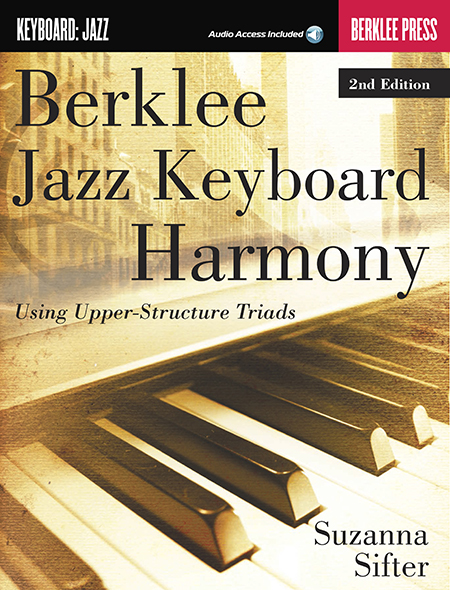Suzanna Sifter is author of Berklee Jazz Keyboard Harmony: Using Upper Structure Triads, an extraordinary book that helps pianists organize and understand tensions in an intuitive and practically applicable way. We just released a second edition of her popular book, and in this interview, Suzanna gives some insight into how to make these relatively advanced ideas more understandable and useful.
Jonathan: What are some of the ways that a “good” jazz improvisation is different than a “bad” jazz improvisation?
Suzanna: It is clear when a player uses his/her ear when improvising, and not simply playing by intellect or rote (“licks”). Improvisation must be spontaneous and totally created in service to what the ear hears. This is honest improvisation. It all begins with ear training.
What common mistakes do you see pianists make when they begin improvising?
Young pianists often run many scales without using their ear. The piano can be played through intellect and bypass the ear, because if the mind knows the scale, it can be played mechanically. It is extremely important to develop the ear. You must listen to what the music wants you to play!
Do you have any advice that you give to your students that often seems to lead them to exponential improvement?
Well, for comping, the “Roman Numeral Method” from my book can revolutionize a pianists’ harmonic palette in just a few months! The tension combinations of an upper-structure triad give that jazz sound that pianists look for. These triads can also be used for reharmonization, improvisation, and composition.
What are upper-structure triads?
Any major, minor, augmented or diminished triad that contains at least one tension of the seventh chord it is played over. For example, an Ab triad over C7(alt) gives a #9 and b13. The left hand plays the guide tones, 3, and b7.
Using upper-structure triads is a way of organizing tensions specific to a seventh chord and its chord scale. Every seventh chord quality has upper-structure triads. For instance, the dominant 7 has the widest array of tension combinations, coming from scales such as Mixolydian, Lydian b7, symmetrical dominant, and altered.
How is using USTs different than simply using a lot of tensions?
When using USTs, the tensions are organized in groups of three. These triads can be easily memorized in colorful combinations. The tensions are connected to specific chord scales theoretically, rather than random sounds. This way you are true to the key, chord progression, chord scale, and chord.
Is there an easy way to remember the rules for tension substitution?
Yes. 9 for 1, and 13 for 5. The 11 usually replaces the 5, but sometimes the 3, as in a sus4 chord.
Should you always actually avoid the “avoid notes”?
“Avoid note” is a teaching term used to train the ear to recognize melodic notes in agreement with a given chord and chord scale. The beginning jazz pianist needs to be able to hear and recognize the differences between seventh chord qualities and their corresponding tensions. Once this work has been accomplished, first begin to experiment with modes of the harmonic minor, harmonic major, and symmetrical scales. These parent scales will introduce newer sounds such as #11 on a minor chord and 9, 11, 13 on a minor 7b5 (harmonic minor). Eventually, the ear can learn to hear any note as “available.”
How has the practice of using tensions evolved during the history of jazz?
In the early and mid 1940s, jazz became more a listening art form rather than dance music. Musicians such as Charlie Parker, Miles Davis, Hank Jones, and Bud Powell developed the faster paced, harmonically rich vocabulary of bebop. The quintessential recording of upper structure triads is played by Bill Evans is “Blue in Green” from the Miles Davis album, Kind of Blue (1958).
How does the ensemble instrumentation affect your note choices?
It’s not so much the instrumentation of the ensemble that matters, but the tune and the style you are playing it in. For instance, if you are playing a tune in the style of Louis Armstrong, your note choices would be closer to the chord tones, with some 9’s. That same tune played in the bebop style would have a more active linear vocabulary and feature more tensions.
Let’s end with some music. Please point us to an inspiring jazz piano performance where the pianist makes good use of upper structure triads.
Well, for that I suggest we just let the music do the talking. These clips below are definitely inspiring jazz piano performances where the pianist makes good use of upper structure triads.
STUDY JAZZ PIANO AT BERKLEE ONLINE










